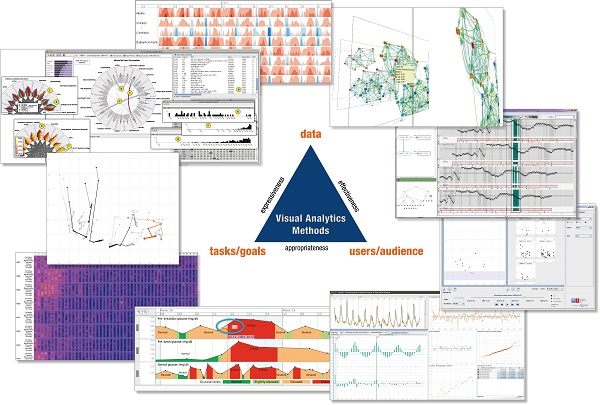CVAST - Centre for Visual Analytics Science and Technology
CVAST aims to design and develop innovative methods for data interpretation to capture the daily flood of information in interactive visualizations and analyses. Scenarios that involve temporal properties of such data are in the focus of our scientific interest.
alternative webpage @ w-fFORTE
Vienna University of Technology - Institute of Software Technology and Interactive Systems (Project Coordination):
- Silvia Miksch, Associate Univ.-Prof., PhD., MSc. (Project Management)
- Wolfgang Aigner, MSc., PhD.
- Roger Almeida Leite, MSc.
- Bilal Alsallakh, MSc, PhD.
- Markus Bögl, MSc.
- Christian Bors, MSc.
- Davide Ceneda, MSc.
- Theresia Gschwandtner, MSc., MSc., PhD.
- Margit Pohl, Associate Univ.-Prof., PhD., MSc.
- Simone Kriglstein, MSc., PhD.
- Nikolaus Suchy
- Peter Bodesinsky, MSc.
- Paolo Federico, MSc.
- Katharina Kaiser, MSc., PhD.
- Claus Stachl, MSc.
- Alexander Rind, MSc.
- Florian Scholz, MSc.
- Sarah Wiener, MSc.
CVAST aims to design and develop innovative methods for data interpretation to capture the daily flood of information in interactive visualizations and analyses. Scenarios that involve temporal properties of such data are in the focus of our scientific interest.
Due to the proliferating capabilities to generate and collect vast amounts of data and information we face the challenge that users and analysts get lost in irrelevant, or otherwise inappropriately processed or presented information. This phenomenon, commonly known as information deluge, overwhelms traditional methods of data analysis such as spreadsheets, ad-hoc queries, or simple visualizations. At the same time, intelligent usage of increasingly available data offers great opportunities to promote technological progress and business success. On this score, Visual Analytics is an emerging research discipline developing methods and technology that make the best possible use of huge information loads in a wide variety of applications. The basic idea is to appropriately combine the strengths of both, computers' and humans' information processing capabilities. To make complex information structures more comprehensible, facilitate new insights, and enable knowledge discovery, methods of visualization, intelligent data analysis, and mining form a symbiosis with the human user via interactive visual interfaces.
The goals of the Centre of Visual Analytics Science and Technology (CVAST) are twofold. The first goal is the integration of the outstanding capabilities of humans in terms of visual information exploration with the enormous processing power of computers to form a powerful knowledge discovery environment. The second goal is to scientifically assess the usability and utility of such discovery environments while bridging the gap between theory and practice for selected application scenarios.
Application scenarios that involve temporal properties are in the focus of our scientific interest. Time - in contrast to other quantitative data dimensions that are usually "flat" - has an inherent structure and distinct characteristics (calendar aspect, natural and social aspects, etc.) which increase its complexity dramatically and demand specialized Visual Analytics methods in order to support proper analysis and visualization. Our expected results will be Innovative, user-oriented, and task-specific Visual Analytics methods and tools with an assessment of their usability and utility. These methods will be used intertwinedly and iteratively to ease the explorative information discovery processes
An appropriate framework for these methods and tools. Their evaluation in 'real life' environments and examination of the information discovery process within several application scenarios. A new methodology to define and evaluate insights facilitated by these methods. Applying these methods within commercial applications to illustrate their business value and economic impacts




























